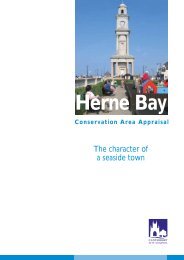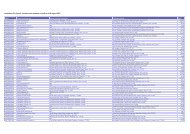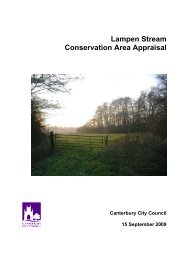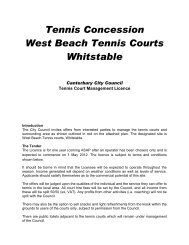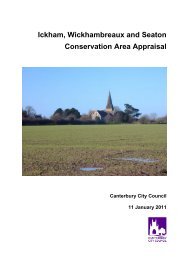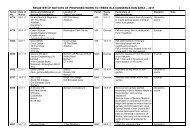Herne Bay and Whitstable Landscape appraisal June 2006
Herne Bay and Whitstable Landscape appraisal June 2006
Herne Bay and Whitstable Landscape appraisal June 2006
You also want an ePaper? Increase the reach of your titles
YUMPU automatically turns print PDFs into web optimized ePapers that Google loves.
The following must be carefully managed to avoid disturbance to the series of special<br />
habitats present in the conservation area, <strong>and</strong> should be considered as part of the<br />
management of any development (following relevant good practice where protected<br />
species (e.g. water voles) are present):<br />
• Sediments entering a nearby or connected water body<br />
• Control or removal of aquatic plants<br />
• Introduction of species<br />
• Control of alien species<br />
• Use of chemicals<br />
• Nutritional enrichment<br />
• Maintenance of ditches <strong>and</strong> water channels to provide shallowly sloping margins to<br />
provide habitat for dragonfly <strong>and</strong> damselfly species<br />
• Impact <strong>and</strong> management of leisure activities<br />
• Water table levels<br />
• Management of scrub<br />
• Provision of scrapes <strong>and</strong> ponds<br />
• Rotational cutting of reedbeds outside of the bird nesting season<br />
• Rotational cutting or intermittent grassl<strong>and</strong> grazing<br />
• Frequency <strong>and</strong> extent of flooding providing beneficial impacts on habitats<br />
• Maintenance of an identified balance between groundwater <strong>and</strong> floodwater levels<br />
• Periodical removal of ditch sediment <strong>and</strong> vegetation<br />
• Field margins <strong>and</strong> hedges<br />
• Sensitive public access<br />
• Sensitive use of machinery (avoid ground compression in sensitive areas)<br />
• Coppice management<br />
• Management of veteran <strong>and</strong> prominent trees in woodl<strong>and</strong> areas <strong>and</strong> the general<br />
l<strong>and</strong>scape<br />
All developments directly or indirectly having an impact upon valued habitats must obtain<br />
an ecological survey by a suitably qualified ecologist. Protected species should always be<br />
considered as part of any development. The impact of a development on biodiversity<br />
should always be considered <strong>and</strong> the biodiversity value enhanced where possible.<br />
There are also a number of agricultural hedgerows within the conservation area that<br />
provide valuable habitat for a number of species. It should be noted that countryside<br />
hedgerows (those not associated with the curtilage of a dwelling) are protected by the<br />
Hedgerow Regulations 1997. These hedgerows cannot be altered (beyond general<br />
maintenance) or removed without 6 weeks prior formal notice being given to the local<br />
planning authority. It should also be noted that the all trees are provided some degree of<br />
protection by the Conservation Area. Any tree located in the conservation area may not be<br />
removed without 6 weeks notice being given to Council.<br />
3. Archaeology <strong>and</strong> Historic Development.<br />
3.1 Archaeology/Evolution<br />
There are no known sites of archaeological interest within the proposed boundaries <strong>and</strong><br />
those, which exist nearby exhibit no recognisable above ground features.<br />
3.2 Recent History<br />
Elbridge House (Listed Grade II) was built about 1803 probably within the site of an earlier<br />
building. Elbridge Farmhouse dates from the 15th century, <strong>and</strong> includes an 18th century<br />
6



